John Beebe assigns the eternal child (puer) to the third function of the personality type for good reason – it is a function that remains weak and childish throughout life.
Here is what Marie-Louise von Franz (Jung’s close associate) says about this function:
The next step in the process of psychic development is to assimilate the two auxiliary functions. One must not forget that the assimilation of these functions is such a difficult task that people generally spend a very long time at it. Sometimes people actually become a certain type, which was not their original type, for eight or ten years.
Lectures on Jung’s Typology, location 1101
The eternal child archetype is the eternal youth in all of us, “the brilliant but volatile side of ourselves that is by turns the seemingly immortal Prince or Princess and the helplessly vulnerable wounded boy or girl.” James Hillman believes that the eternal child has a special relationships to the transcendent spiritual powers of the unconscious.
The puer aetrnus comes from the child god Iacchus in the Elusinian mysteries “who was identified with the new birth these rites promised individuals who partook of them”. In a clinical setting Beebe says the eternal child is someone who displays a “false individualism.” He quotes Marie-Louise von Franz: an “arrogant attitude towards other people due to both an inferiority complex and false feelings of superiority. Such people also usually have great difficulty in finding the right kind of job, for whatever they find is never quite right or quite what they wanted.”
The parent and child functions are complements both within the psyche and between people. These two functions are the ones we lean on in our interactions with others. Our child function will be attracted to the parent form of that same function in others. For example, an INFJ has introverted thinking as the child function and will be attracted to the parent form of it in the ENTP and ESTP. The ESTJ has extroverted intuition as the child function and will be attracted to the parent form of it in the INTP and INFP. And so on.
Paralysis can overtake the eternal child function because it is hard to sustain the activity of this function. Beebe describes its up and down quality as “inflation/deflation cycle” and as a “third function crisis.” The shadow form of this function is the trickster function and it is this function that makes it hard to use our eternal child function. This will be the topic of my next post on the functions.
Sources:
Energies and Patterns of Psychological Type by John Beebe
Lectures on Jung’s Typology by Marie-Louise von Franz and James Hillman
